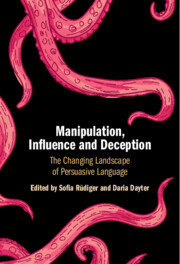Book contents
- Manipulation, Influence and Deception
- Manipulation, Influence and Deception
- Copyright page
- Contents
- Figures
- Tables
- Contributors
- I (Re)framing Persuasion
- II Persuasion and (New) Contexts of Use
- III The Dark Side of Persuasion
- 8 The Importance of Context in Analysing the Incitement of Violence
- 9 ‘I’d Say That Being Here Has Helped Me’
- 10 Language, Manipulation, and Online Radicalisation
- IV Persuasion and Algorithms
- V Discussion
- Index
- References
8 - The Importance of Context in Analysing the Incitement of Violence
A Case Study of an Online Community
from III - The Dark Side of Persuasion
Published online by Cambridge University Press: 10 June 2025
- Manipulation, Influence and Deception
- Manipulation, Influence and Deception
- Copyright page
- Contents
- Figures
- Tables
- Contributors
- I (Re)framing Persuasion
- II Persuasion and (New) Contexts of Use
- III The Dark Side of Persuasion
- 8 The Importance of Context in Analysing the Incitement of Violence
- 9 ‘I’d Say That Being Here Has Helped Me’
- 10 Language, Manipulation, and Online Radicalisation
- IV Persuasion and Algorithms
- V Discussion
- Index
- References
Summary
This study explores the importance of a full(er) understanding of ‘context’ when analysing and interpreting the indirect incitement of violence, a speech act closely related to that of persuasion. Using descriptions of context from Systemic Functional Linguistics (Bowcher, 2014; Hasan, 2014, 2020), the chapter qualitatively examines a small number of selected extracts from a very particular online community – a pick-up artist (PUA) forum. The main argument here is that the contextual configuration of the discourse, in terms of the nature the community and the participants in it, is such that posts which on the face of it appear to be giving advice or expressing opinions could be potentially inciteful in this context. Incitement has typically received relatively little linguistic attention, and indirect incitement poses a specific challenge for linguistics and law alike. This chapter goes some way to providing a new perspective from which the elusive discursive action of incitement can be analysed and interpreted.
Keywords
Information
- Type
- Chapter
- Information
- Manipulation, Influence and DeceptionThe Changing Landscape of Persuasive Language, pp. 157 - 176Publisher: Cambridge University PressPrint publication year: 2025
References
Accessibility standard: Inaccessible, or known limited accessibility
Why this information is here
This section outlines the accessibility features of this content - including support for screen readers, full keyboard navigation and high-contrast display options. This may not be relevant for you.Accessibility Information
Content Navigation
Allows you to navigate directly to chapters, sections, or non‐text items through a linked table of contents, reducing the need for extensive scrolling.
Provides an interactive index, letting you go straight to where a term or subject appears in the text without manual searching.
Reading Order & Textual Equivalents
You will encounter all content (including footnotes, captions, etc.) in a clear, sequential flow, making it easier to follow with assistive tools like screen readers.
Visual Accessibility
You will still understand key ideas or prompts without relying solely on colour, which is especially helpful if you have colour vision deficiencies.
You benefit from high‐contrast text, which improves legibility if you have low vision or if you are reading in less‐than‐ideal lighting conditions.
